
Zafar Mahal, located in Mehrauli village in South Delhi, is considered the last monumental structure built as a summer palace during the waning years of the Mughal era. The complex has two main components: the palace (Mahal) itself, initially constructed by Akbar Shah II in the 18th century, and the entrance gate, which was reconstructed in the 19th century by Bahadur Shah Zafar. Zafar (whose name means “Victory”) was the last Mughal emperor, although there is hardly anything victorious left in the Zafar Mahal today.

The palace has a melancholic history because Bahadur Shah Zafar, who wished to be buried within the precincts of Zafar Mahal and near the famous Dargah of Khwaja Qutubuddin Bakhtiar Kaki in Mehrauli, Delhi, was instead deported by the British to Rangoon after the First War of Indian Independence in 1857. He died there of old age. Today, the Zafar Mahal is in a neglected and ruined state, with unauthorized constructions all but subsumed the 18th-century palace.


The palace, located about 90m west of the Ajmeri Gate of the dargah of Khwaja Kaki, has an imposing gate built in 1842 by Akbar Shah II. The three-storied red sandstone structure, adorned with marble, is around 15m wide. The Hathi Gate, designed to allow fully decorated elephants to pass through, has a 3.6m wide entrance.
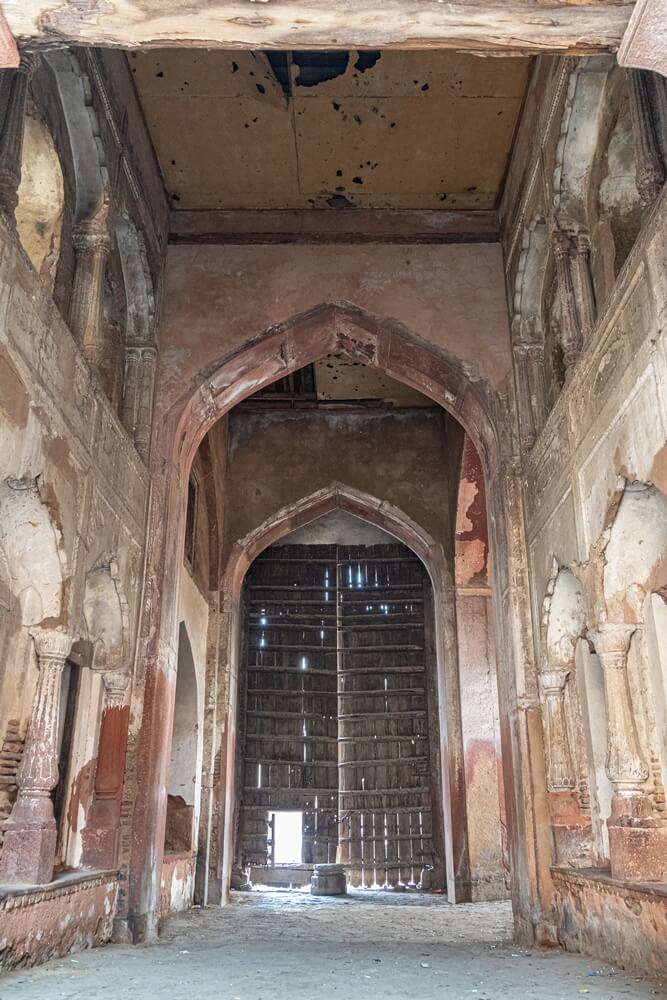

An inscription on the main arch credits the gate’s construction as an entry to the existing Mahal by Bahadur Shah Zafar in the eleventh year of his reign in 1847-48 CE. The arch features a broad Chhajja (cantilevered projection) in the Mughal style, small projecting windows flanked by curved Bengali domes, and ornate medallions in the form of large lotuses on either side. The gateway also includes a classic three-arch opening leading to the baaraadare (12-opening structure) which allows ample airflow.


The palace’s top floor includes a multi-chambered dalan (arcade room with one open side overlooking a courtyard), with terraces offering views of the entrance.


The Chhatta Chawk or vaulted arcade design of the Lahore gate at the Red Fort in Delhi inspired the Zafar gate’s design. The arcade, a large covered passage with arched apartments on either side, has rooms within its enclosures and runs south and east directions from the gate.
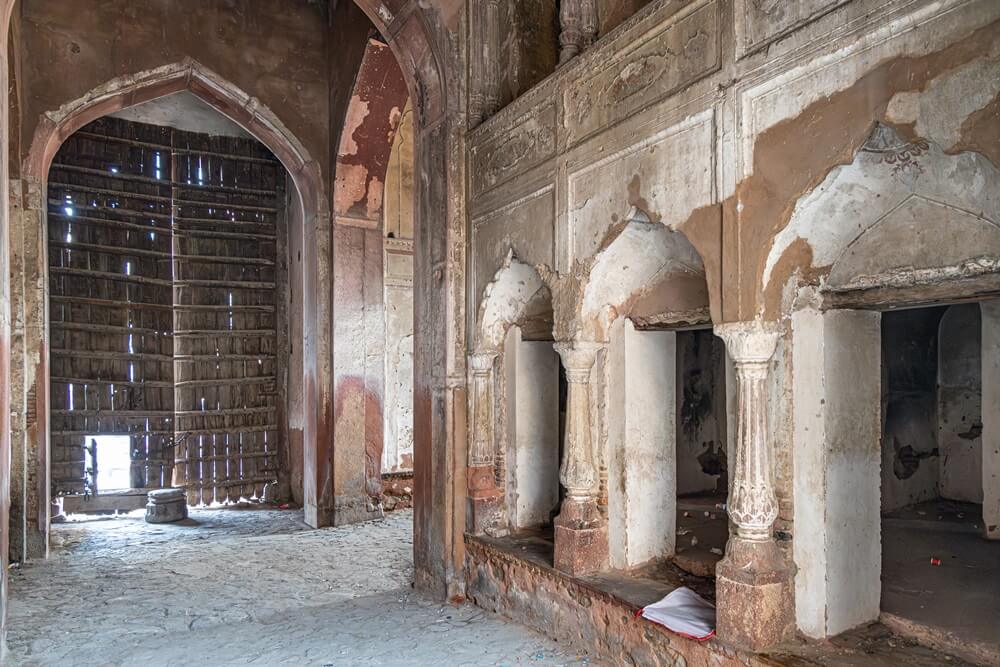
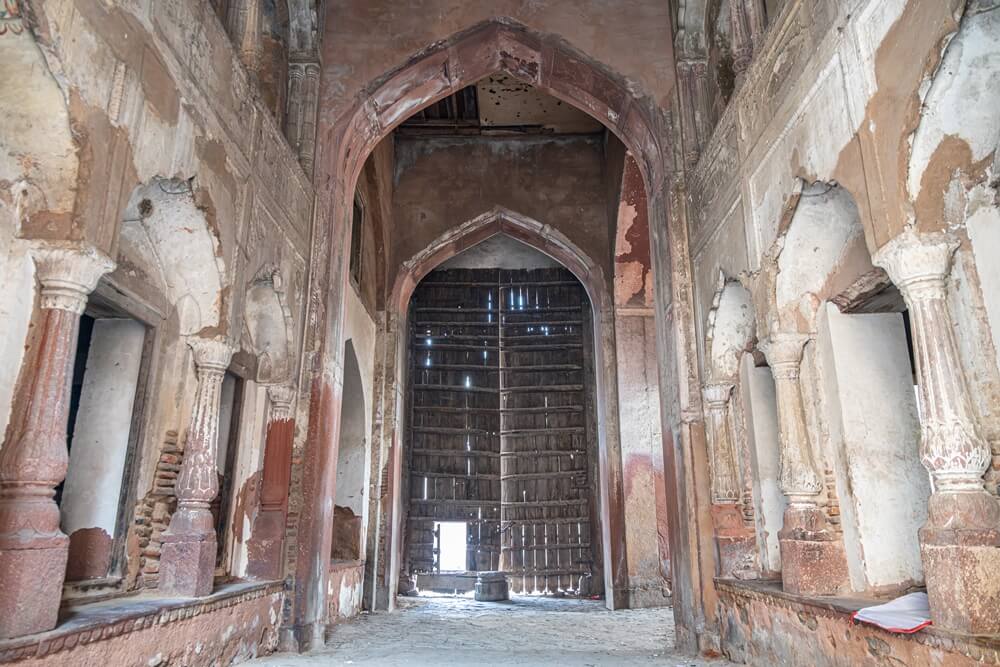
The palace, located a few steps down from the arcade, is now dilapidated. Its restoration is hampered by insufficient documentation to determine its original construction details. The Archaeological Survey of India (ASI) document “List of Mohammedan and Hindu Monuments” from March 1920 provides only sketchy details.
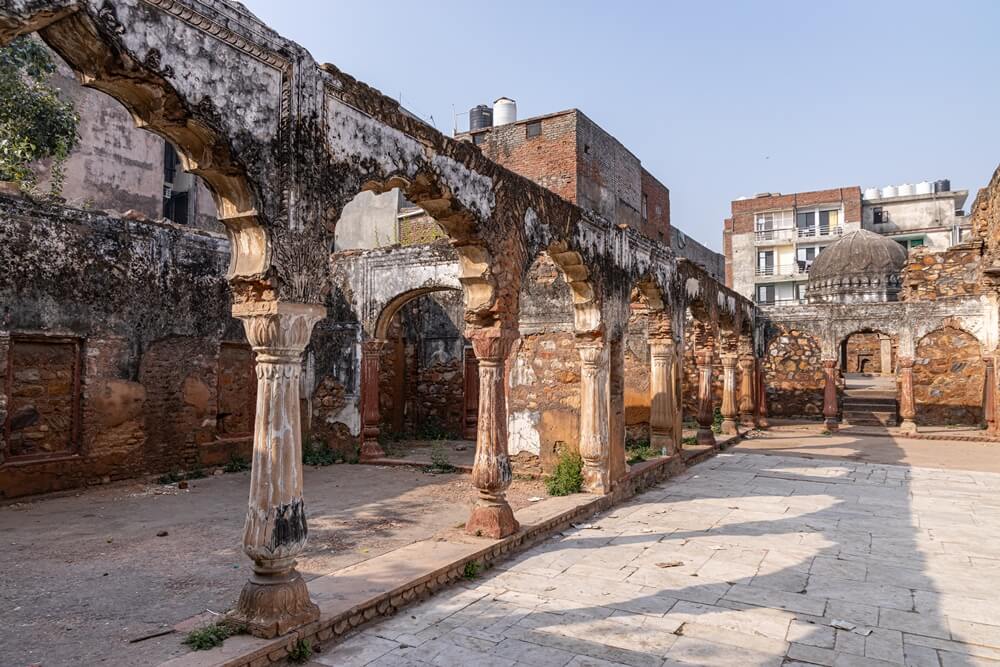


Bahadur Shah Zafar visited this palace annually for hunting during the monsoon season and was honored here during the Phool Walon Ki Sair (Flower Sellers’ Procession) festival held in February/March. It was once a vast complex with many structures, now mostly lost or occupied by local residents. These included:
Baoli of Aurangzeb
Built by Emperor Aurangzeb, this stepwell measured 40m by 11m, with a well 9m in diameter, containing 74 steps built in three stages. It is now an uphill road with homes, shops, and warehouses.
House of Mirza Babur
Built during Akbar II’s reign, Mirza Babur’s house had a central court and seven bay verandas, while the southern side housed stables. A Mughal mosque marked the northern side. Parts of this house still exist, now housing over a dozen families.
Diwan-e-Khaas of Bahadur Shah Zafar
Located approx 30m northwest of Zafar Palace or Hathi Gate, this two-storied building had ground and first floors with a row of arches on the eastern side. A red sandstone staircase on the northern side led to the first floor, and the ground floor included a courtyard measuring 12m, surrounded by an arched portico.
House of Mirza Nili
Located south of Aurangzeb’s baoli, this house had an arched entrance from the market side, with verandas on the western and northern sides of the courts, built in a modern style.
House of Mirza Salim
Located 45m north of Zafar Mahal, this double-storied house, built in late Mughal style, was constructed during Akbar Shah II’s reign. It featured a southeastern red sandstone gateway leading to Zafar Mahal’s forecourt. Mirza Salim was the son of Akbar II and brother of Bahadur Shah Zafar.
Thana of Bahadur Shah Zafar
Situated 45m south of Mirza Nili’s house, it was found in ruins by archaeologist Maulvi Zafar Hasan in 1920.
Khwas Pura
Quarters for the royal palace’s maidservants, consisting of an inner court with verandas on all sides. By the early 20th century, this area was owned by a person named Ahmed Hasan, with water carriers living there.

Within the palace precincts is the Moti Masjid (Pearl Mosque), a private mosque for the royal family, built by Bahadur Shah I (d.1712). It was later incorporated into the palace compound.


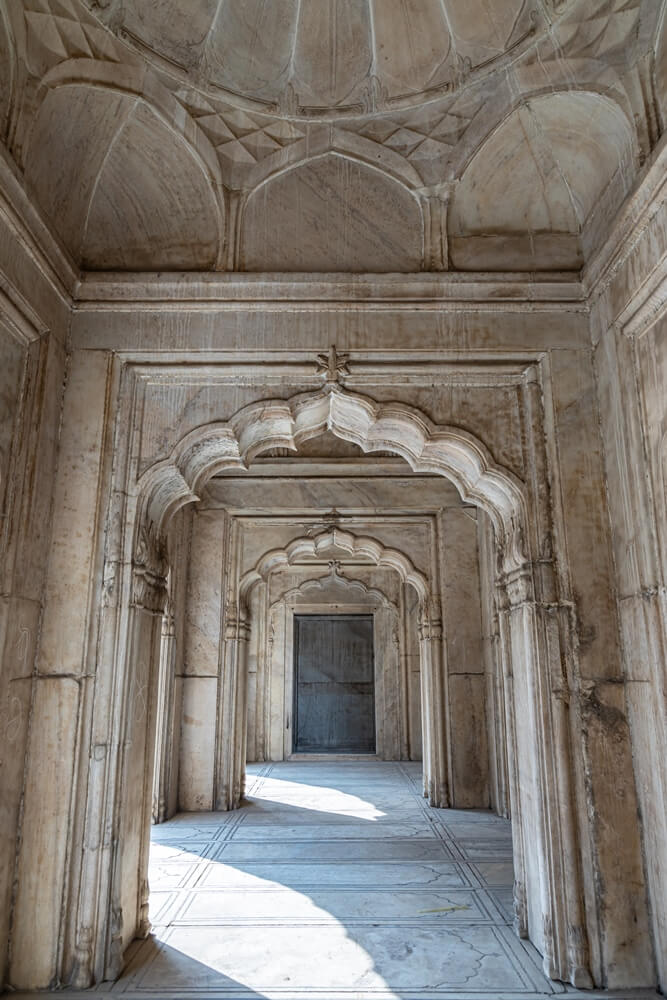

This small, three-domed structure made of white marble is unique for its austere design, featuring a mihrab on the west but minimal embellishment, except for a floral carving border on the south at the top edge of the dado.


Within Zafar Mahal’s precincts, enclosed by a marble screen built by Jahandar Shah, are the graves of his father, Bahadur Shah I, and two other Mughal Emperors.

Shah Alam II, who was blinded by Rohilla leader Ghulam Qadir and considered a “puppet ruler” under the Marathas and later the British, is buried here. His son, Akbar Shah II, is also buried here.


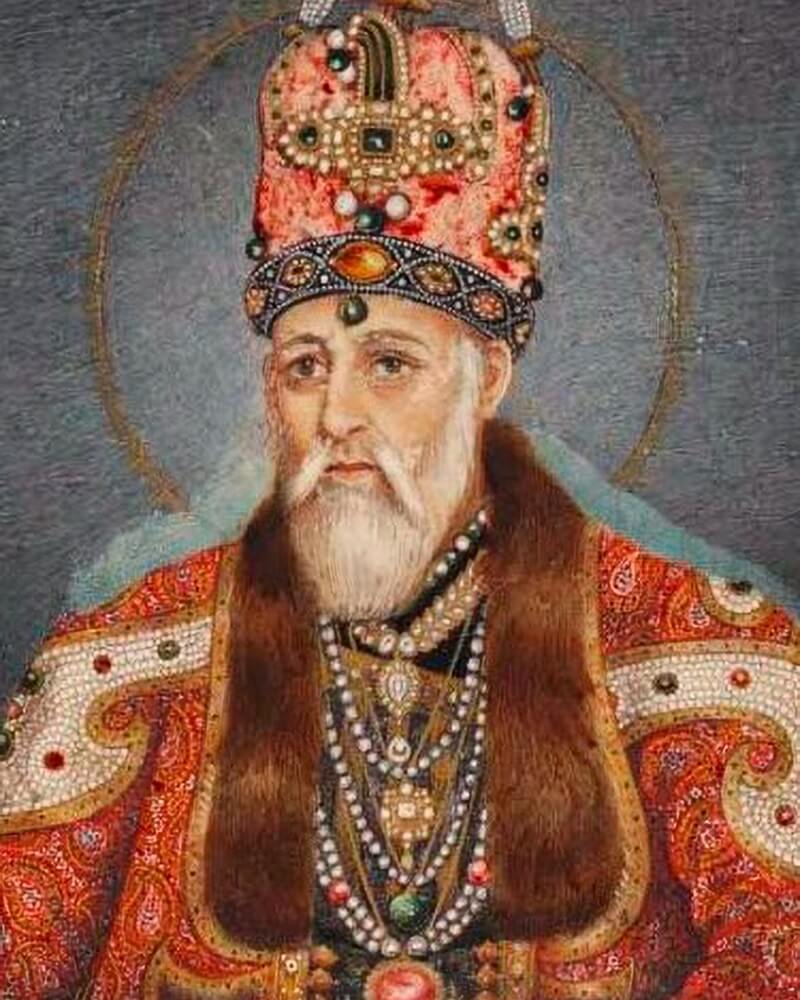

Mirza Fakruddin, son of Bahadur Shah Zafar, who died early, ushered in the end of the Mughal regime and was also interred at this place. However, Bahadur Shah Zafar, who had specifically chosen this site for his own grave, was not laid to rest here.
The Mughal dynasty, which began with Babur’s conquest of Delhi in 1526 CE, ended after 332 years when Bahadur Shah Zafar was tried for treason by the British and deported from Delhi to Rangoon, Burma (now Yangon in Myanmar), on 7th October 1858.

Public domain, via Wikimedia Commons
The exiled emperor died fours years later in November 1862 and was buried urgently at night by lantern light, in the presence of a few family members under the direction of a British officer. Initially, his grave was unmarked, but a tablet was later erected in the 20th century near the assumed location. His grave has since become a shrine after a chance rediscovery of his tomb in 1991 by workers who were digging for a drain. Zafar is respected as an “Emperor-Saint,” and hence his shrine has become an important place for pilgrimage by Muslims. It is said that Indian nationalist leader Subhas Chandra Bose took a formal oath at Zafar’s grave to free India from foreign rule.


Public domain, via Wikimedia Commons
Bahadur Shah Zafar, known as the poet-king, wished to be buried next to his predecessors Bahadur Shah I, Shah Alam II, Akbar Shah II, and their families in the sardgah (grave) in the marble enclosure near the dargah of 13th-century Sufi saint Qutbuddin Bakhtiyar Kaki in Zafar Mahal. He had a special attachment to this place, particularly the tomb of Qutb Kaki, the Sufi saint of the Chisti order, as he was his mureed (disciple).

In Rangoon prison, Bahadur Shah Zafar penned the famous couplet “do gaz zameen,” lamenting his fate of not finding a place for his burial in his homeland:
do gaz zameen
lagtā nahī̃ hai jī mirā ujṛe dayār mẽ
kis kī banī hai ālam-e-nā-pāedār mẽbulbul ko pāsbā̃ se na sayyād se gilā
qismat mẽ qaid likkhī thī fasl-e-bahār mẽkah do in hasratõ se kahī̃ aur jā basẽ
itnī jagah kahā̃ hai dil-e-dāġdār mẽik shāx-e-gul pe baiṭh ke bulbul hai shādmā̃
kā̃ṭe bichā diye hãi dil-e-lālāzār mẽumr-e-darāz māṅg ke lāe the cār din
do ārzū mẽ kaṭ gae do intizār mẽdin zindagī ke xatm hue shām ho gaī
phailā ke pāõ soeṅge kūñj-e-mazār mẽkitnā hai badnasīb zafar dafn ke lie
do gaz zamīn bhī na milī kū-e-yār mẽ
Two yards of Land
My heart has no repose in this despoiled land
Who has ever felt fulfilled in this futile world?The nightingale complains about neither the sentinel nor the hunter
Fate had decreed imprisonment during the harvest of springTell these longings to go dwell elsewhere
What space is there for them in this besmirched heart?Sitting on a branch of flowers, the nightingale rejoices
It has strewn thorns in the garden of my heartI asked for a long life, I received four days
Two passed in desire, two in waiting.The days of life are over, evening has fallen
I shall sleep, legs outstretched, in my tombHow unfortunate is Zafar! For his burial
Not even two yards of land were to be had, in the land of his beloved.

Declared a protected monument in 1920 under the Ancient Monuments Preservation Act, 1904, Zafar Mahal is now encroached upon by new structures built on parts of its southern and eastern walls. The Indian National Trust for Art and Cultural Heritage (INTACH) lists it as a conservation area. The ASI proposed establishing a Mughal Museum in the palace in 2009 to encourage visitors and remove extensive encroachments. However, no work has taken place to set up the museum or remove illegal encroachments. Despite its “protected monument” status, vandalism and encroachment incidents are common due to negligence.




Within the last year and since my visit to Zafar Mahal, the Jali screens around the graves have been vandalized. You can read about this latest round of destruction here.
Please ‘Like’ or add a comment if you enjoyed this blog post. If you’d like to be notified of any new content, just sign up by clicking the ‘Follow’ button. If you have enjoyed this or any other of my posts, please consider buying me a coffee. There’s a facility to do so on the righthand side of this website for desktop users, and just above the comment section for mobile users. Thank you !
If you’re interested in using any of my photography or articles please get in touch. I’m also available for any freelance work worldwide, my duffel bag is always packed ready to go…
KevinStandage1@gmail.com
kevinstandagephotography.wordpress.com
Categories: Delhi, India, Zafar Mahal & Moti Masjid




